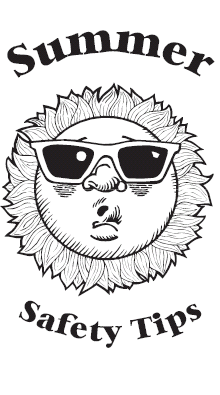Grilling Safety
Fire Safety Education

According to the NFPA, gas and charcoal grills caused an average of 1,500 structure fires and 4,800 outdoor fires in or on home properties in 1999. To make sure your next barbecue doesn't go up in flames, the Home Safety Council recommends the following safety tips:
- Designate the grilling area a "NO PLAY ZONE" keeping kids and pets well away until grill equipment is completely cool.
- Before using, position your grill at least 5 feet away from other objects, including the house and any shrubs or bushes.
- Fire officials recommend LP gas canisters be 10 feet away from the house, if possible, especially when in use.
- Only use starter fluid made for barbecue grills when starting a fire in a charcoal grill.
- Before using a gas grill, check the connection between the propane tank and the fuel line to be sure it is working properly and not leaking.
- Never use a match to check for leaks. If you detect a leak, immediately turn off the gas and don't attempt to light the grill again until the lead is fixed.
- Never bring a barbecue grill indoors, or into any unventilated space. This is both a fire and carbon monoxide poisoning hazard.
- All LP-gas cylinders with a capacity between 4-40 lbs. must be equipped with an overfill protection device.
- LP-gas grills are not permitted inside or on balconies above the first floor of any building where people live.
- LP-gas is heavier than air and sinks. A leaky grill could pose a hazard to people below. Possible ignition sources include smoking materials, air conditioners, compressors, pilot lights and cars.
- Make sure all connections are tight and secure.
CHARCOAL GRILLS
- Use only charcoal lighter fluid to start charcoal grills.
- Once the coals have been lighted, never add more lighter fluid to the fire - flames may travel up the stream of lighter fluid resulting in serious burns.

